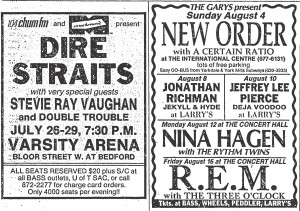Site Analysis: Historical Research on Locations
This is the first of a series of posts that will walk you through the main aspects of the upcoming assignment in which you analyze a site. The project is divided into two component: a historical study of the site and a study of the contemporary use of music in that site. This post will deal with the first of these, a second post will deal with the contemporary study. A third post will set up some of our discussions about interview techniques on Thursday.
We tend to think about historical research as something that involves important people and major world events, in this assignment you’ll be focusing on places that haven’t likely played a role in ending a war or debates between national leaders. How, then, do you research a location that is just “normal”? Part of the problem with researching these types of locations is that people tend to forget what was there. A new business, a new building, often replaces what was there previously entirely…or at least it’s quite muddy. This is why, for the historical part of this assignment, it is not sufficient to just go by what you hear from the people you speak with or what you yourself remember or what is part of the lore attached to a particular venue. It will be necessary for you to do some original research into the locations you are studying.
Not everything you turn up will be related to music, but I expect you to be able to document the history of the site using original sources or authoritative scholarly research.
Stage One: Names Change, Addresses Don’t (…well, usually)
Once you’ve selected your locale, your first recourse should be a search of newspapers from the area. In the case of Toronto, this would be the Toronto Star and the Globe & Mail (although, depending on the period, there are other papers such as the Telegram.) To do historical research using these materials, you should use the databases available via the York Library website. They can be found on this page. In beginning your search, you should be attentive to the date range that is covered in the database. Make a note of this for your records so that later you can explain where you searched in need be. Now you are ready to start looking:
1) You should search the databases for two things:
a) The name of the venue you have selected (and any short forms that may be used.)
b) The address of the venue you have selected. The name of the venue may have changed, but addresses tend to stay the same over time. In rare cases, the addresses have changed (for example, the name of Dupont Street was Royce Avenue in the early part of the 20th century.)
In what you find, you should look for evidence of the kind things that were taking place in that location. What does this say about how the space was used? In looking at the articles, you should also look for sharp cut-offs in mentions. So, in the case of a theatre or concert hall, is there a date before which there is no mention? In the case of this, you should try to determine if this was because the venue was new or if this was because it changed name or booking policy (say moving from being a venue for private events to a public space.).
What you find, however, might not be immediately clear. Take, for example, the ad below. Some of the event’s took place in places we may know, but do we know about the bands? Also, what about the venue’s that don’t exist any more? Where (and what) was “Larry’s“?

Advertisement for Concerts from The Toronto Star, from July 1985.
2) If you’re looking at an area where the newspaper has not been digitized, you should locate a copy of the newspaper on microfiche. Local libraries should have these, the Toronto Reference library also has copies of many regional newspapers. Since the search function doesn’t usually work here, you should concentrate your search on parts of the paper that might refer to the location. In the case of entertainment venues (theatres, concert halls, restaurants), this will involve looking through weekly listings and advertisements to see if there is any mention.
Stage Two: City Records and Local Archives
If you’ve come up empty with searches of newspapers, another way to find out more about the location is to consult with the records that are available at the city archive of the area you are researching. Usually housed at branches of the library system, they have access to collections ranging from survey maps of the area to floor plans of particular sites and sometimes information about deeds and transfers involving the sale and purchase of particular addresses and areas.
Before going, you should make an appointment with the archivist (if necessary) to discuss your research. They will be able to help you locate the materials you will need. Again, you may be looking for a particular venue, but usually you’ll be looking for an address or, in the case of newer properties, lot numbers.
Here are links to the archives of Toronto, Mississauga and Hamilton. Others should be accessible online as well.
I’ll say this many times, but it bears repeating. If you have questions or concerns, come speak with me about the project and perhaps we can figure something out.
